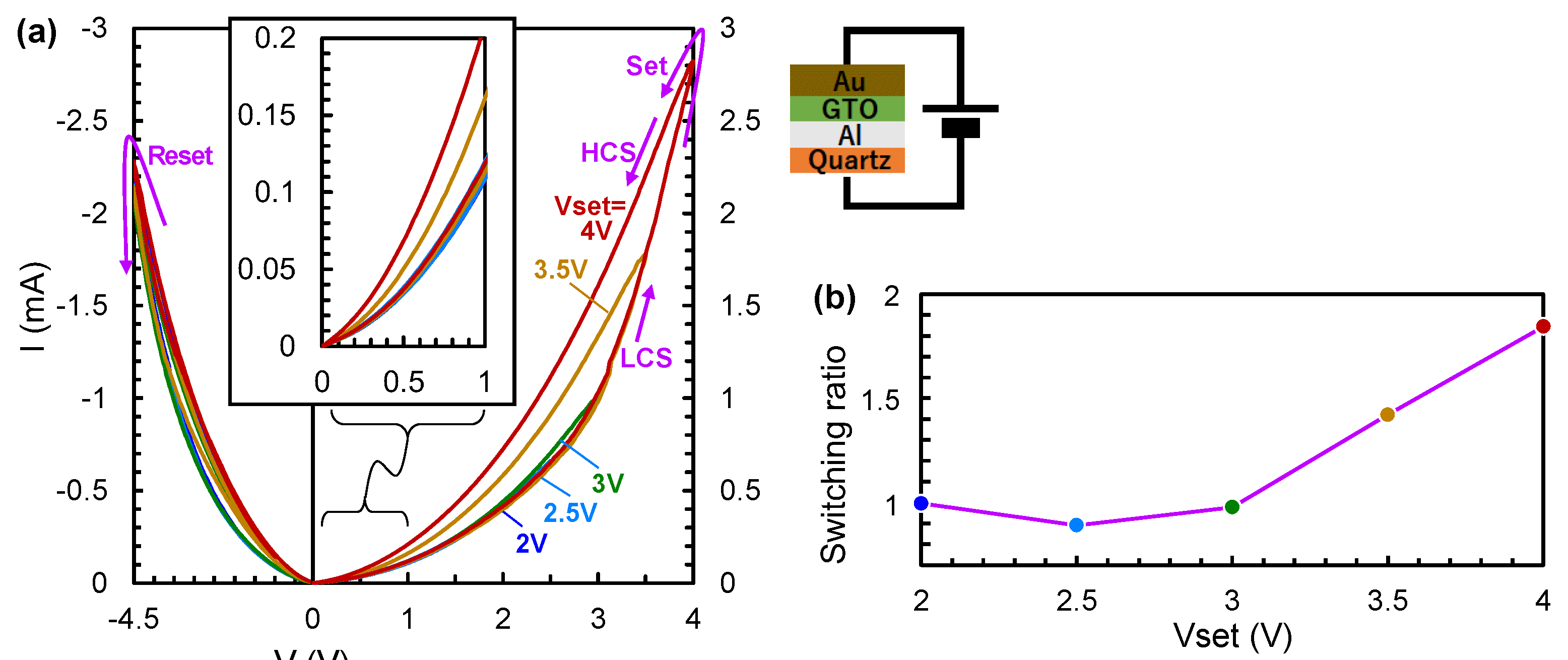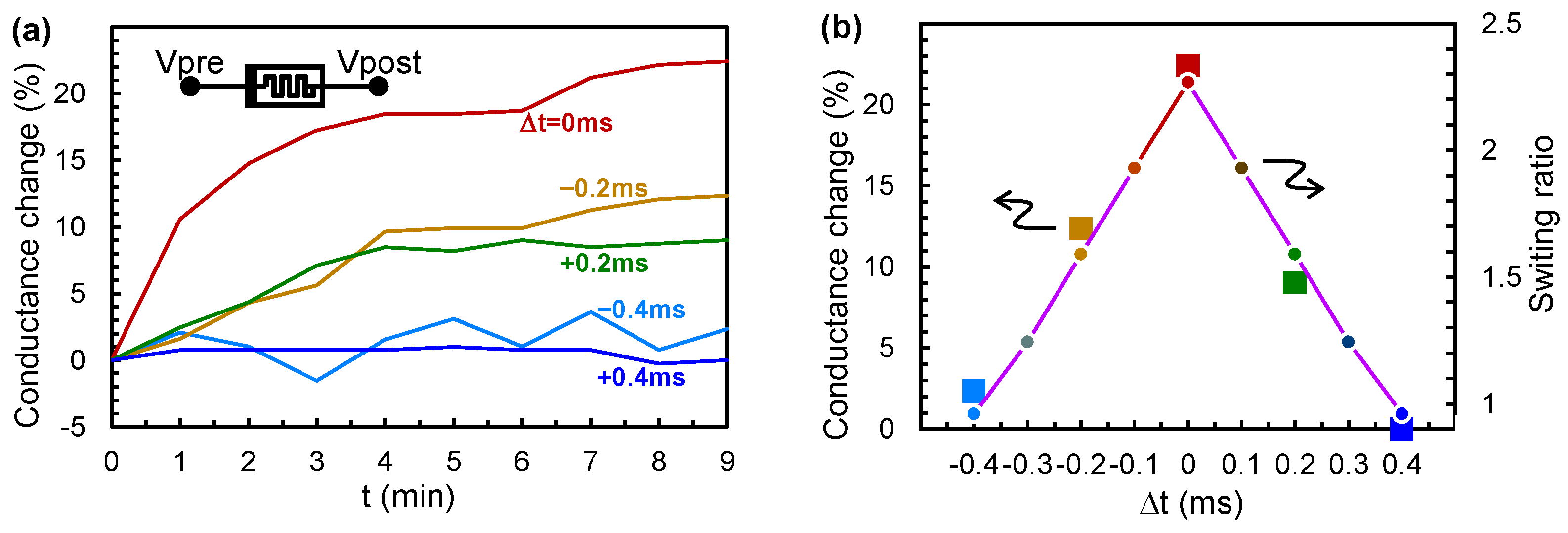Spike-Timing-Dependent Plasticity Device with Ga-Sn-O Conductance Change Layer Deposited by Mist-CVD Method
Abstract
1. Introduction
2. STDP Device with a GTO Conductance Change Layer Deposited by a Mist CVD Method
3. Memristive Characteristic
4. Spike Waveforms
5. STDP Characteristic
6. Conclusions
Author Contributions
Funding
Data Availability Statement
Conflicts of Interest
References
- McCarthy, J.; Minsky, M.L.; Rochester, N.; Shannon, C.E. A proposal for the Dartmouth Summer Research Project on artificial intelligence. AI Mag. 1955, 27, 12. [Google Scholar]
- Zhang, C.; Lu, Y. Study on artificial intelligence: The state of the art and future prospects. J. Ind. Inf. Integr. 2021, 23, 100224. [Google Scholar] [CrossRef]
- McCulloch, W.S.; Pitts, W. A logical calculus of the ideas immanent in nervous activity. Bull. Math. Biophys. 1943, 5, 115–133. [Google Scholar] [CrossRef]
- Aggarwal, C.C. Neural Networks and Deep Learning: A Textbook; Springer: Berlin/Heidelberg, Germany, 2018. [Google Scholar]
- Greenemeier, L. Will IBM’s Watson Usher in a New Era of Cognitive Computing? Scientific American, 13 November 2013. [Google Scholar]
- Lohr, S. What ever happened to IBM’s Watson? The New York Times, 16 July 2021. [Google Scholar]
- Lande, T.S. Neuromorphic Systems Engineering, Neural Networks in Silicon; Springer Science & Business Media: Berlin, Germany, 2013. [Google Scholar]
- Mohamed, K.S. Neuromorphic Computing and Beyond: Parallel, Approximation, Near Memory, and Quantum; Springer: Cham, Switzerland, 2020. [Google Scholar]
- Strukov, D.B.; Snider, G.S.; Stewart, D.R.; Williams, R.S. The missing memristor found. Nature 2008, 453, 80–83. [Google Scholar] [CrossRef] [PubMed]
- Chen, Y. ReRAM: History, status, and future. IEEE Trans. Electron Devices 2020, 67, 1420–1433. [Google Scholar] [CrossRef]
- Prezioso, M.; Merrikh-Bayat, F.; Hoskins, B.D.; Adam, G.C.; Likharev, K.K.; Strukov, D.B. Training and operation of an integrated neuromorphic network based on metal-oxide memristors. Nature 2015, 521, 61–64. [Google Scholar] [CrossRef]
- Yao, P.; Wu, H.; Gao, B.; Tang, J.; Zhang, Q.; Zhang, W.; Yang, J.J.; Qian, H. Fully hardware-implemented memristor convolutional neural network. Nature 2020, 577, 641–646. [Google Scholar] [CrossRef]
- Simanjuntak, F.M.; Ohno, T.; Chandrasekaran, S.; Tseng, T.-Y.; Samukawa, S. Neutral oxygen irradiation enhanced forming-less ZnO-based transparent analog memristor devices for neuromorphic computing applications. Nanotechnology 2020, 31, 26LT01. [Google Scholar] [CrossRef]
- Zeng, F.; Guo, Y.; Hu, W.; Tan, Y.; Zhang, X.; Feng, J.; Tang, X. Opportunity of the lead-free all-inorganic Cs3Cu2I5 perovskite film for memristor and neuromorphic computing applications. ACS Appl. Mater. Interfaces 2020, 12, 23094–23101. [Google Scholar] [CrossRef]
- Das, U.; Sarkar, P.; Paul, B.; Roy, A. Halide perovskite two-terminal analog memristor capable of photo-activated synaptic weight modulation for neuromorphic computing. Appl. Phys. Lett. 2021, 118, 182103. [Google Scholar] [CrossRef]
- Hu, L.; Yang, J.; Wang, J.; Cheng, P.; Chua, L.O.; Zhuge, F. All-optically controlled memristor for optoelectronic neuromorphic computing. Adv. Funct. Mater. 2021, 31, 2005582. [Google Scholar] [CrossRef]
- Peng, Z.; Wu, F.; Jiang, L.; Cao, G.; Jiang, B.; Cheng, G.; Ke, S.; Chang, K.-C.; Li, L.; Ye, C. HfO2-based memristor as an artificial synapse for neuromorphic computing with tri-layer HfO2/BiFeO3/HfO2 design. Adv. Funct. Mater. 2021, 31, 2107131. [Google Scholar] [CrossRef]
- Li, Y.; Ang, K.-W. Hardware implementation of neuromorphic computing using large-scale memristor crossbar arrays. Adv. Intell. Syst. 2021, 3, 2000137. [Google Scholar] [CrossRef]
- Meng, J.-L.; Wang, T.-Y.; He, Z.-Y.; Chen, L.; Zhu, H.; Ji, L.; Sun, Q.-Q.; Ding, S.-J.; Bao, W.-Z.; Zhou, P.; et al. Flexible boron nitride-based memristor for in situ digital and analogue neuromorphic computing applications. Mater. Horiz. 2021, 8, 538–546. [Google Scholar] [CrossRef] [PubMed]
- Park, S.-O.; Jeong, H.; Park, J.; Bae, J.; Choi, S. Experimental demonstration of highly reliable dynamic memristor for artificial neuron and neuromorphic computing. Nat. Commun. 2022, 13, 2888. [Google Scholar] [CrossRef]
- Milojicic, D.; Bresniker, K.; Campbell, G.; Faraboschi, P.; Strachan, J.P.; Williams, S. Computing In-Memory, Revisited. In Proceedings of the 2018 IEEE 38th International Conference on Distributed Computing Systems (ICDCS), Vienna, Austria, 2–6 July 2018; pp. 1300–1309. [Google Scholar] [CrossRef]
- Maass, W. Networks of spiking neurons: The third generation of neural network models. Neural Netw. 1997, 10, 1659–1671. [Google Scholar] [CrossRef]
- Bi, G.Q.; Poo, M.M. Synaptic modifications in cultured hippocampal neurons: Dependence on spike timing, synaptic strength, and postsynaptic cell type. J. Neurosci. 1998, 18, 10464–10472. [Google Scholar] [CrossRef]
- Wittenberg, G.M.; Wang, S.S.H. Malleability of spike-timing-dependent plasticity at the CA3–CA1 synapse. J. Neurosci. 2006, 26, 6610–6617. [Google Scholar] [CrossRef]
- Buchanan, K.A.; Mellor, J.R. The development of synaptic plasticity induction rules and the requirement for postsynaptic spikes in rat hippocampal CA1 pyramidal neurons. J. Physiol. 2007, 585, 429–445. [Google Scholar] [CrossRef]
- Buchanan, K.A.; Mellor, J.R. The activity requirements for spike timing-dependent plasticity in the hippocampus. Front. Synaptic Neurosci. 2010, 2, 11. [Google Scholar] [CrossRef]
- Serrano-Gotarredona, T.; Masquelier, T.; Prodromakis, T.; Indiveri, G.; Linares-Barranco, B. STDP and STDP variations with memristors for spiking neuromorphic learning systems. Front. Neurosci. 2013, 7, 2. [Google Scholar] [CrossRef] [PubMed]
- Nomura, K.; Ohta, H.; Takagi, A.; Kamiya, T.; Hirano, M.; Hosono, H. Room-temperature fabrication of transparent flexible thin-film transistors using amorphous oxide semiconductors. Nature 2004, 432, 488–492. [Google Scholar] [CrossRef] [PubMed]
- Lu, J.-G.; Kawaharamura, T.; Nishinaka, H.; Kamada, Y.; Oshima, T.; Fujita, S. Zno-based thin films synthesized by atmospheric pressure mist chemical vapor deposition. J. Cryst. Growth 2007, 299, 1–10. [Google Scholar] [CrossRef]
- Dang, G.T.; Kawaharamura, T.; Furuta, M.; Allen, M.W. Metal-semiconductor field-effect transistors with In–Ga–Zn–O channel grown by nonvacuum-processed mist chemical vapor deposition. IEEE Electron Device Lett. 2015, 36, 463–465. [Google Scholar] [CrossRef]
- Matsuda, T.; Umeda, K.; Kato, Y.; Nishimoto, D.; Furuta, M.; Kimura, M. Rare-metal-free high-performance Ga-Sn-O thin film transistor. Sci. Rep. 2017, 7, 44326. [Google Scholar] [CrossRef]
- Sugisaki, S.; Matsuda, T.; Uenuma, M.; Nabatame, T.; Nakashima, Y.; Imai, T.; Magari, Y.; Koretomo, D.; Furuta, M.; Kimura, M. Memristive characteristic of an amorphous Ga-Sn-O thin-film device. Sci. Rep. 2019, 9, 2757. [Google Scholar] [CrossRef]
- Takishita, Y.; Kobayashi, M.; Hattori, K.; Matsuda, T.; Sugisaki, S.; Nakashima, Y.; Kimura, M. Memristor property of an amorphous Sn–Ga–O thin-film device deposited using mist chemical-vapor-deposition method. AIP Adv. 2020, 10, 035112. [Google Scholar] [CrossRef]




Disclaimer/Publisher’s Note: The statements, opinions and data contained in all publications are solely those of the individual author(s) and contributor(s) and not of MDPI and/or the editor(s). MDPI and/or the editor(s) disclaim responsibility for any injury to people or property resulting from any ideas, methods, instructions or products referred to in the content. |
© 2024 by the authors. Licensee MDPI, Basel, Switzerland. This article is an open access article distributed under the terms and conditions of the Creative Commons Attribution (CC BY) license (https://creativecommons.org/licenses/by/4.0/).
Share and Cite
Kita, H.; Uno, K.; Matsuda, T.; Kawanishi, H.; Kimura, M. Spike-Timing-Dependent Plasticity Device with Ga-Sn-O Conductance Change Layer Deposited by Mist-CVD Method. Electronics 2024, 13, 3413. https://doi.org/10.3390/electronics13173413
Kita H, Uno K, Matsuda T, Kawanishi H, Kimura M. Spike-Timing-Dependent Plasticity Device with Ga-Sn-O Conductance Change Layer Deposited by Mist-CVD Method. Electronics. 2024; 13(17):3413. https://doi.org/10.3390/electronics13173413
Chicago/Turabian StyleKita, Hidehito, Kazuma Uno, Tokiyoshi Matsuda, Hidenori Kawanishi, and Mutsumi Kimura. 2024. "Spike-Timing-Dependent Plasticity Device with Ga-Sn-O Conductance Change Layer Deposited by Mist-CVD Method" Electronics 13, no. 17: 3413. https://doi.org/10.3390/electronics13173413
APA StyleKita, H., Uno, K., Matsuda, T., Kawanishi, H., & Kimura, M. (2024). Spike-Timing-Dependent Plasticity Device with Ga-Sn-O Conductance Change Layer Deposited by Mist-CVD Method. Electronics, 13(17), 3413. https://doi.org/10.3390/electronics13173413





